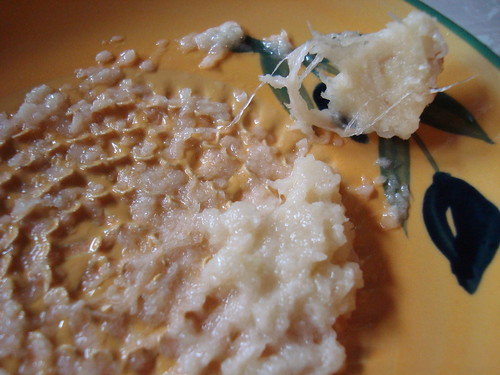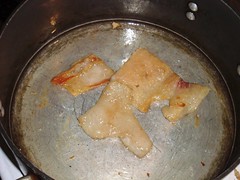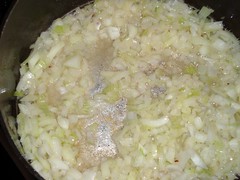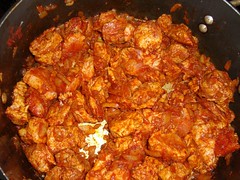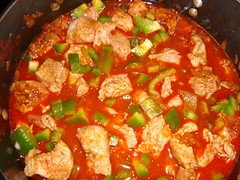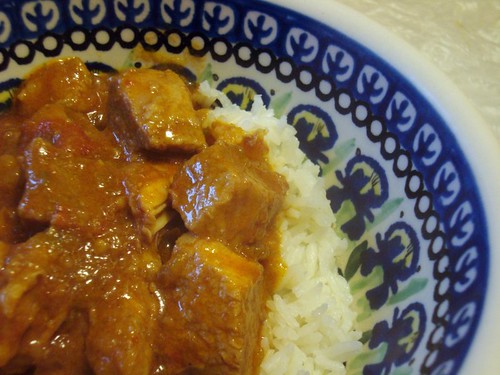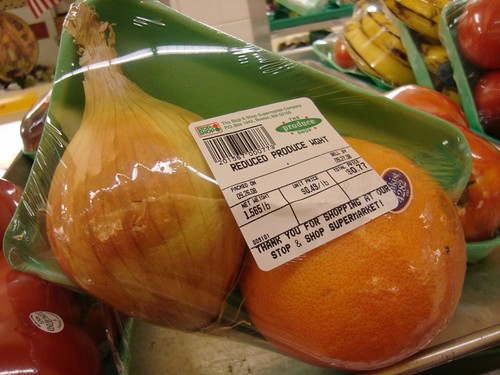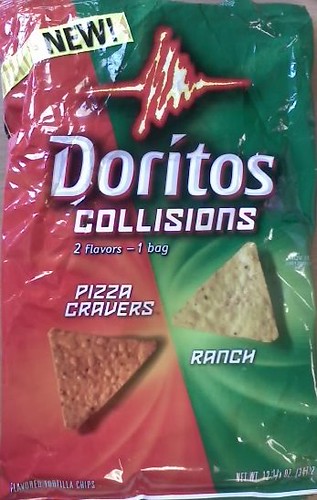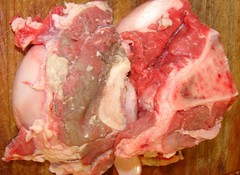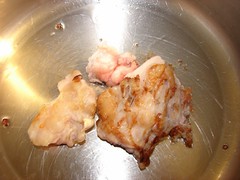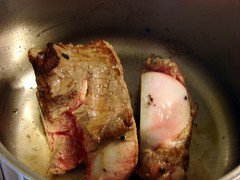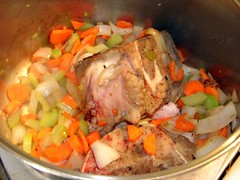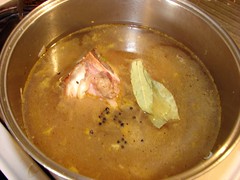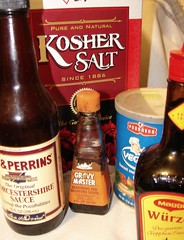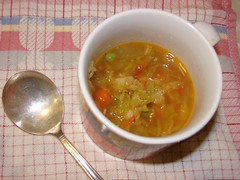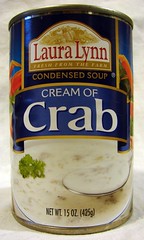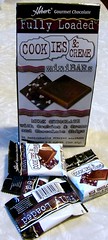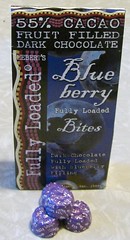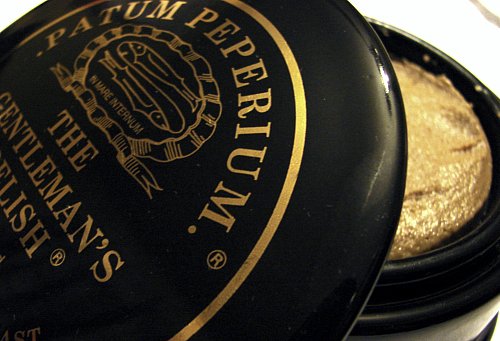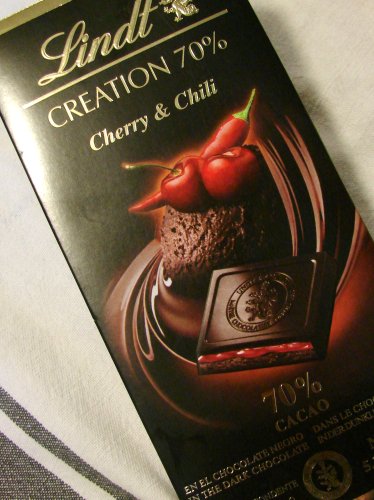The Eastern States Exposition, or Big E for short, is a seventeen day State Fair participated in by all six New England states. It was originally a traditional agricultural fair, but these days the agricultural element is almost an afterthought - the Big E advertising hardly even mentions it anymore; judging is pretty much limited to a handful of sheep and cattle events and the only crops that get show off these days are giant pumpkins.
The "exhibits" now are mostly hucksters selling stuff out of tents lining every paved and unpaved traffic route, sideshow-style come-ons (SEE THE GIANT HORSE FOR JUST $1!!) and food vendors.

There are a ton of food vendors, and they're found in two main areas of the fairgrounds: on the midway and on The Avenue of the States - a broad boulevard that runs past six brick buildings - replicas of each of the original New England statehouses. The food vendors in the State Buildings tend to highlight foods emblematic of the agricultural and culinary traditions of the region. I'm going to take you on a tour of the delicious foods found in each of the State Buildings at the fair.
Connecticut
Most of the exhibits in the Connecticut building seem to be centered around manufacturing and corporate image. Timex has a prominent booth near the front of the building, Lego has a huge exhibit along the back, and of course the huge Foxwoods casino has a massive footprint as well. The Department of Agriculture has been relegated to a tiny booth off to one side.
Foodies will still find a few things of interest here, however. Candymaker
Pez is headquartered in Orange, CT, and has a huge exhibit and sales booth they call the Pez Farmer's Market where you can buy a wide variety of Pez flavors and hard-to-find dispensers.
There's also
Emilee's Italian Ices (smooth and delicious and very refreshing after walking our feet off at the fair) and
7th Heaven Spice Company. Based in Windsor, CT, 7th Heaven has built a huge and far-reaching reputation with their online sales; those of us who live in North Central Connecticut are lucky enough to find them at local supermarkets. Protip: They have one of the
best blends of jerk spice I've ever tried, and their habanero powder is second to none.
Around the back of the building you'll find
Rosco's Big Dog dishing up their famous hot dogs and fries. The hot dogs are truly awesome, but skip the steamed burgers. Ted's in Meriden or
Coach D's in Springfield Massachusetts do them better, and there are lots of other great foods waiting for you in the other buildings.
New Hampshire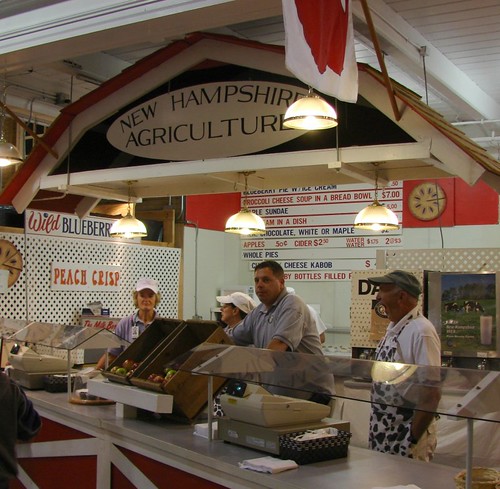
The highlight of the New Hampshire building for foodies is the New Hampshire Agriculture exhibit. Wild blueberry pie, delicious peach crisp, and maple sundaes are all on offer, as well as New Hampshire-grown fresh apples. Our favorite was the maple flavored milk.
Maine
The Maine building is where the serious eating begins. One of the most popular food concessions at the entire fair is located here: Maine baked potatoes, loaded. This concession started years ago in a small booth area on the south side of the building. As time went on and the potatoes became more popular, the line for them made getting around in the Maine building nearly impossible. Today, the line forms under a canopy outside the south wall and snakes through several turns and lanes before bringing hungry spudfans to the actual concession. The potatoes are delicious, and toppings include freshly minced chives, sour cream, rich butter, and crunchy crumbled bacon (all of which are produced on Maine farms.) It's a treat, but thanks to the long line we decided to skip it this year.
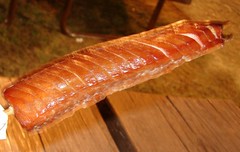
One thing we never skip is the smoked salmon on a stick, sold by
Maine-ly Smoked Salmon of Perry. They sell some of the very best hot-smoked salmon I've ever tasted - expertly done over applewood - and it's one of the few commercial products that I can honestly say is as good as the fish that comes out of my own smoker. At the same booth, we bought some
Capt'n Eli's Blueberry Soda, made by the
Shipyard Brewing Company of Portland. It was very refreshing; not overly sweet but with a strong fresh blueberry flavor and a very fine carbonation that sort of melted away as we drank. They were also selling the equally excellent Capt'n Eli's Root Beer, a wonderful, premium draft-style rootbeer as rich and creamy as anything you can remember from your childhood.
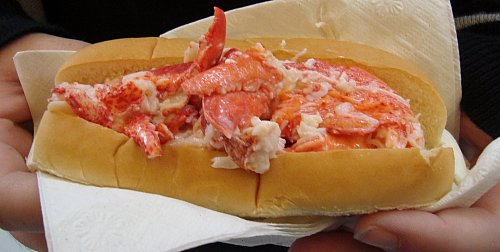
No visit to the Maine building would be complete, of course, without a lobster roll, and these were made with big chunks of claw and tail meat, bound together with a kiss of melted butter, and stuffed into split-top New England-style hot dog rolls. Classic.
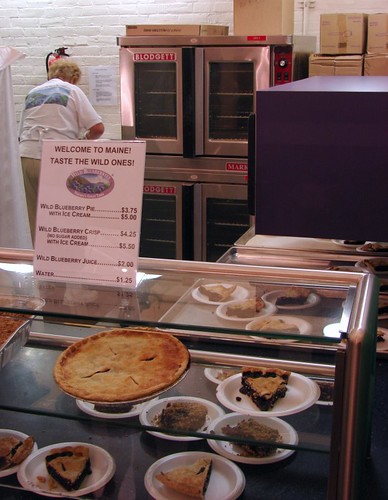
The
Wild Blueberry Association of North America, headquartered in Old Town, had a large and wonderful exhibit selling wild blueberry juice, delicious wild blueberry pie, and an absolutely outstanding wild blueberry cobbler that was made with no added sugar.

The pie and the cobbler were the best desserts at the fair.
Massachusetts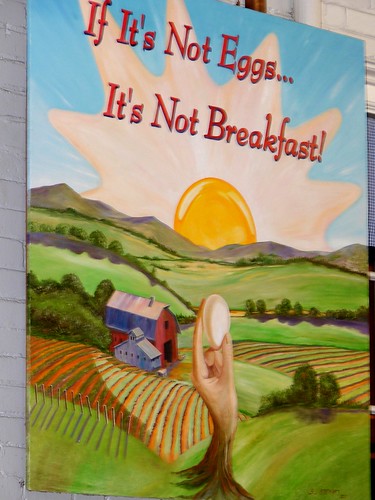
The Massachusetts Building was a lot of fun, starting with this marvelously surreal poster advertising eggs. It was hanging up over a display of products which included big ol' jars of my favorite bar food, pickled eggs.
One of the biggest exhibits was at the
Massachusetts Maple Producers Association. Although Vermont maple syrup is a lot more famous, Massachusetts produces a decent quantity of excellent maple syrup and sugar as well. They had sugar products of all kinds as well as syrup and cotton candy. I picked up a small bag of maple sugar candies to use in my coffee later - I love the slightly smoky brown flavor that maple sugar gives to my coffee.
Our other favorite stops here were at
Koffee Kup Bakery. They're an old-time donut shop/bakery with two locations in Western Massachusetts (one in Springfield and one in Holyoke), carrying on a New England tradition by baking all of their products from scratch on site just like they have for the past 60 years. If you're ever traveling through Springfield, you should try to get to the Springfield Plaza on Liberty Street to visit them - they have one of the
coolest surviving neon signs you could ever hope to see.
The last plug I'll make for a Massachusetts business in their state building is for
The Granville Country Store. They were selling several varieties of their excellent aged sharp cheddar cheese, and it was flying off the shelves. The actual store is located in Granville Massachusetts, off of Route 57 - kind of off the beaten track - and visitors to the fair were taking full advantage of the easy access at the state building. Their cheddar is the rival of any I've had anywhere else.
VermontFor the most part, I found the Vermont building to be rather disappointing. The famous Vermont cheddar cheese was represented solely by Cabot, at prices almost 75% higher than shoppers could find at any supermarket in the area. And while the
Cold Hollow Cider Company was serving up delicious apple pie and had fudge that my daughter found irresistable, their "fresh" apple cider was actually pasteurized, not fresh. Thankfully, one food vendor there consistently outshines the rest and makes the Vermont building an actual destination:
American Flatbread. They have built one of their wood-fired beehive ovens there inside the Vermont building, and serve up astoundingly delicious 100% all-natural organic pizza.
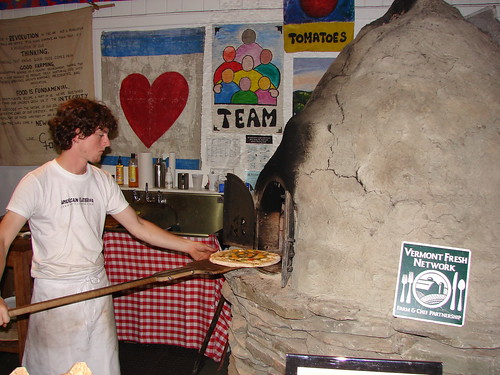

We enjoyed a pepperoni slice (perfectly baked flatbread topped with mozzarella and wide slices of nitrite-free pepperoni) and a tomato-pesto slice (flatbread again, topped with mozzarella, sweet yellow cherry tomatoes, and green swirls of delicious homemade pesto.) Over the years since they first appeared at the Big E, American Flatbread has built themselves quite a reputation; although their pizza is quite a bit more expensive than the ordinary 'za available from vendors out on the midway, it is much tastier and quite popular - you're almost guaranteed to wait at least a few minutes in line (but the service is fast and friendly, and the wood-fired pizza is well worth a few minutes pause and a few dollars premium.)
Rhode Island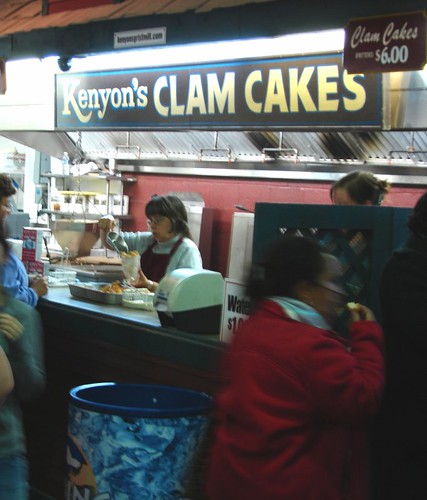
Last, but by no means least, we visited the Rhode Island building, where the
Kenyon Corn Meal Company has become another of the "destination" food vendors, thanks to their popular clam cakes. I chatted with a few of the folks waiting with me for our turn to buy a bag of clam cakes, and more than one of them told me that Kenyon's is their first stop when they arrive at the fair. (I don't find that hard to believe at all: it is usually our first stop as well.) The clam cakes are always light and tender, and even contain the occasional fragment of clam. The concession also sells some of the best chowder ever made.
Across the aisle from Kenyon's is
Tucker Seafood, selling a wide variety of seafood, fish, and shellfish. Their chowder is excellent and their fish and chips is second to none. That isn't to say that everything they sell is instant win, however; they make a quahog chili (using chopped quahog instead of ground beef for the main component of the dish) which is, quite simply,
heinous.
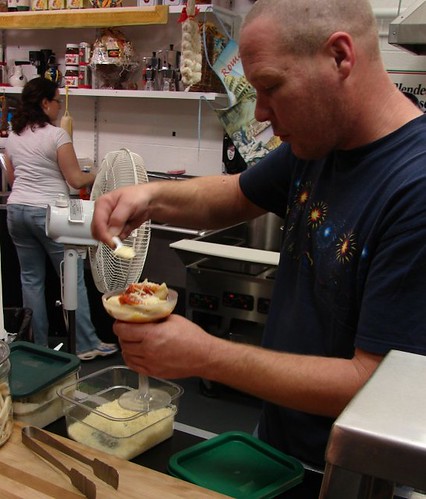
And so, with all these tasty delights, what was the best thing we ate on the Avenue of the States? That would have been here, at
Constantino's Venda Ravioli where we were served the best lobster ravioli we've ever tasted. Served with your choice of red sauces (vodka, marinara, or bolognese) and an optional sprinkle of freshly grated parmesan cheese, each serving consists of four 3-inch-square ravs stuffed with lobster filling. And this is no stingy bit of shredded lobster with lots of breadcrumb filling, either - we're talking respectable chunks of knuckle meat. You know you're eating lobster in this ravioli.
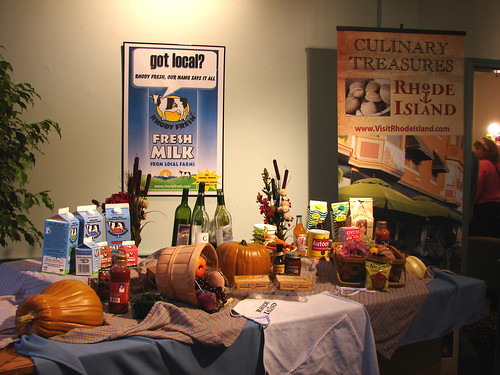
Two other mentions before I finish up this post - both are local companies that weren't represented in the State Buildings, but set up on the midway among the typical carny food vendors selling their deep fried oreos, corn dogs, and caramel apples:
 Millie's Pierogis
Millie's Pierogis are a fixture in the Pioneer Valley. The company is located in Chicopee, Massachusetts, and they sell their pierogi in supermarkets all over the Valley and into Northern Connecticut. They're one of the best commercially-produced pierogi anywhere, and every single one of them is made by hand, just as though your own Polish grandmother was sitting in your kitchen rolling out the dough herself.
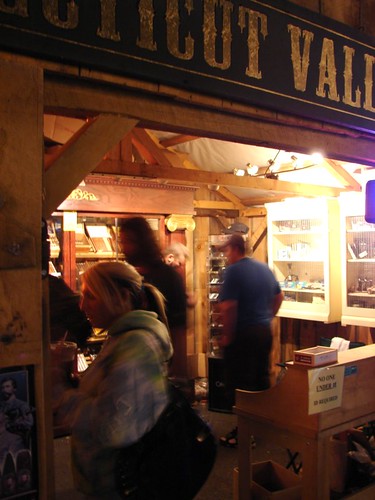 Connecticut Valley Tobacconist
Connecticut Valley Tobacconist has a charming post-and-beam storefront on the midway. Broadleaf and shade tobacco has been grown in Connecticut for centuries and is still an important cash crop for many of our farmers. And Connecticut Valley leaf has an impeccable reputation; it is used to wrap some of the finest cigars in the world (and was the preferred wrapper for the best Cuban cigars until the revolution and subsequent US embargo on trade with Cuba.)
The store has a wide selection of cigars, domestic and imported, many of which incorporate Connecticut-grown leaf, and carries their own house brand of cigar. At intervals throughout the day, the store also has demonstrations of how hand-made cigars are rolled.
Eastern States Exposition (The Big E)1305 Memorial Avenue
West Springfield, MA 01089
(413) 737-2443
New England's Great State Fair
 Then last week I went to The Big E. We were on our way out of the fairgrounds when one of the sales hucksters caught my eye - he was demonstrating the type of stoneware garlic grater that I had so admired in my brother-in-law's kitchen! The ones the Garlic Man were selling didn't have the rustic charm of the funky-looking grater my brother-in-law bought, but it works just as well and it was, after all, still hand crafted in Europe. Plus, the charming yellow glaze goes well in my sunny yellow kitchen.
Then last week I went to The Big E. We were on our way out of the fairgrounds when one of the sales hucksters caught my eye - he was demonstrating the type of stoneware garlic grater that I had so admired in my brother-in-law's kitchen! The ones the Garlic Man were selling didn't have the rustic charm of the funky-looking grater my brother-in-law bought, but it works just as well and it was, after all, still hand crafted in Europe. Plus, the charming yellow glaze goes well in my sunny yellow kitchen.